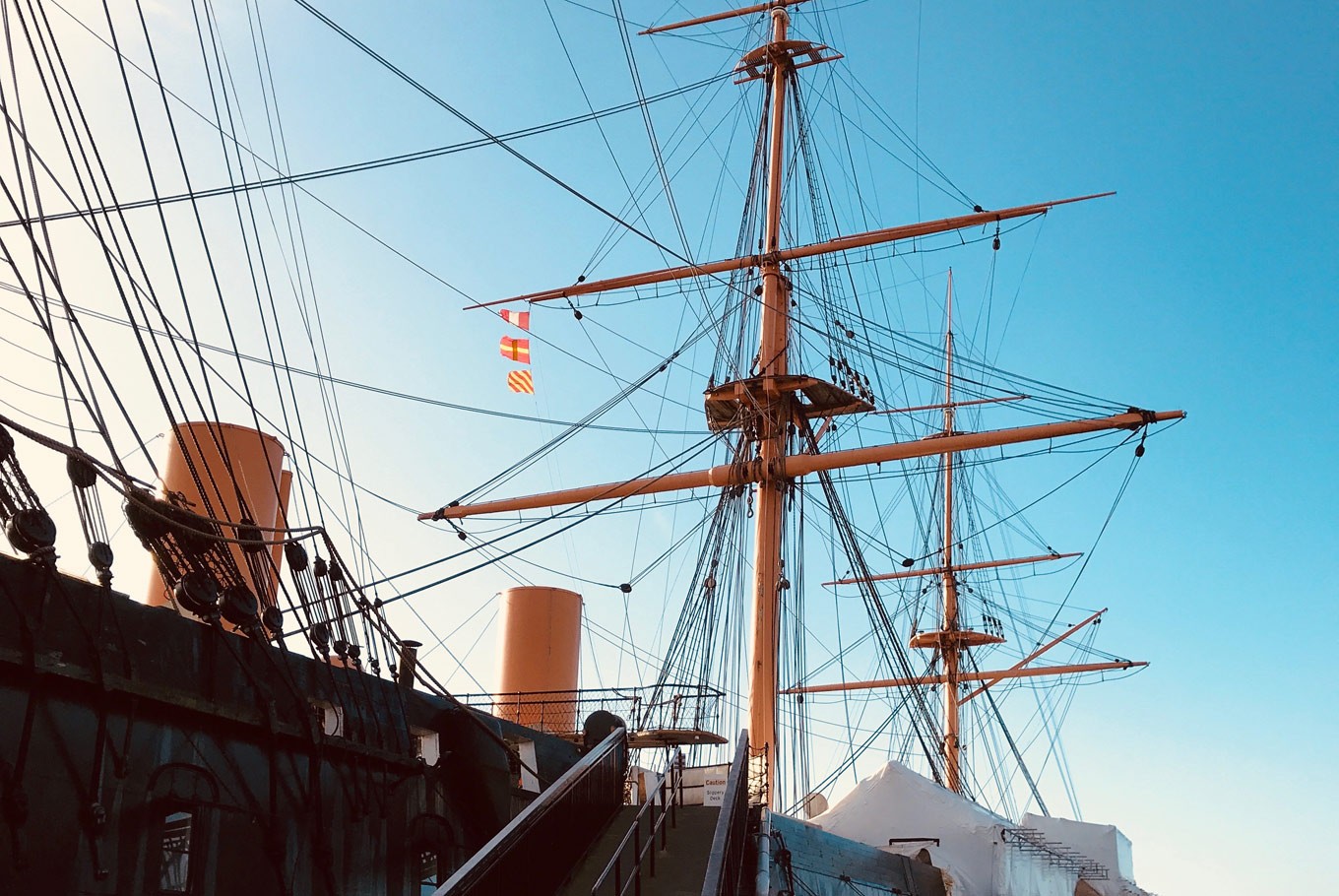Popular Reads
Top Results
Can't find what you're looking for?
View all search resultsPopular Reads
Top Results
Can't find what you're looking for?
View all search resultsA day at the docks with world's oldest warship
As a naval facility that dates back to the end of the 15th century, the Portsmouth is replete with the historical buildings and ships that made up the Royal Navy’s illustrious history.
Change text size
Gift Premium Articles
to Anyone
 HMS Warrior (JP/Tunggul Wirajuda)
HMS Warrior (JP/Tunggul Wirajuda)
T
he ship’s three decks bristled with 12, 24 and 32-pound cannons, like during the vessel’s heyday in the 18th and early 19th centuries. The artillery pieces’ loading and cleaning kit was placed overhead, ready to pack gunpowder and cannonball for a shot or clean out the barrel before reloading. A sailor’s hammock hung nearby, showing how the ship’s spaces doubled as the crew’s living quarters and action stations.
The ship was none other than the HMS Victory, the world’s oldest commissioned warship.
Today it is one of the highlights of the Portsmouth Historic Dockyard, a part of the Royal Navy base in Portsmouth, England that is open to the public. As a naval facility that dates back to the end of the 15th century, the area is replete with the historical buildings and ships that made up the Royal Navy’s illustrious history. They include the aforementioned HMS Victory, HMS Mary Rose, and the HMS Warrior.
Prepare to step back in time as we board these ships and other highlights of the Dockyard.
HMS Victory
The HMS Victory was still able to awe and inspire more than 250 years since it was launched in 1765, not least because of its history and 104 cannons. While the vessel served in various conflicts over a 50-year period, its finest hour came during the Napoleonic Wars in 1805, when it served as Vice Admiral Lord Horatio Nelson’s flagship when he saved Britain from a French invasion at the decisive battle of Trafalgar. His triumph was tinged with tragedy, as he was killed on board the ship. The great admiral’s presence filled the Victory, among them in his room or the Great Cabin, the Captain’s cabin, as well as the dining room where he dined with his officers. The ship’s refinements are balanced by its grim mementos like the surgeon’s ward and the dark, dank lower decks. The Victory’s muskets and swords stood ready to arm the ship’s sailors and marines. Now its oak decks echoed with the steps of tourists instead of crewmen preparing for battle.
The Victory’s revered place in British history enabled it to evade the scrap yard in the years following Trafalgar. “HMS Victory has been sitting in a dry dock in Portsmouth since 1922 supported by 22 steel cradles positioned 6 meters apart. [The ship] has welcomed over 30 million visitors since it opened in 1928,” said the Portsmouth Historic Dockyard in its website http://www.historicdockyard.co.uk/hms-victory-support.
But the Victory is no mere museum ship. “[The] Victory is possibly the most famous ship in the world. She remains a commissioned ship and the flagship of the [Royal Navy’s] First Sea Lord,” added National Museum of the Royal Navy Director General Professor Dominic Tweddle.
While the Victory has survived French cannonballs, German bombs in World War Two, and other challenges, time proved to be its most implacable enemy. To prevent this, the Royal Navy and BAE Systems have spent over £3 million in technology to conserve the vessel since 2011. These include a new support system designed to simulate the ship in water, removing the Victory’s masts, and repainting the ship’s hull.
The work didn’t stop the Victory from receiving visitors, making a tour of its decks a trip for the ages.
The Mary Rose
Like the Titanic, the Mary Rose earned its fame for sinking to the bottom of the ocean. A centerpiece of the 16th century Royal Navy, the Mary Rose went down off Portsmouth as it sailed out to fight in the Battle of the Solent in 1545. King Henry VIII witnessed the tragedy first-hand. A team led by British diver Alexander McKee salvaged the ship in 1982, over a decade after they detected the wreck in 1971. Maryrose.org cited four possible causes, among them human error, bad weather, sunk in action by the French, and overloading.
Nearly 500 years after its sinking, the Mary Rose resurfaced in 1984 within a museum built around the ship. Run by the Mary Rose Trust, the museum boasted over 19 thousand artifacts. They include dozens of coins strewn in as historical objects, instead of currency to pay the crew. Other exhibitions provided glimpses of life on board the 16th century navy. These include suits of armor, uniforms of the period, and a couple of longbows similar to those which equipped archers on the ship. The latter particularly drew visitors’ attention, as they can try their luck in drawing back the bow.
While the artifacts drew passerby, the whole museum was still dominated by the ship’s hull. Bathed in an unearthly ultra-violet light that permeated the whole museum, the rays helped preserve the structure from further decay by carefully controlling the temperature and humidity. The light also gave the place a contemplative air that helped one feel for their plight and added understanding of their era.
HMS Warrior 1860
Visitors who arrived in Portsmouth by bus or train would find HMS Warrior a familiar sight, as it was often the first thing they see on arriving in the city. While the ship might not have the HMS Victory’s fame, dramatic history or iconic stature, it was nevertheless renowned for its innovativeness as Britain’s first ironclad or iron hulled, armored battleship. “Launched in 1860, at a time of empire and Britain’s dominance in trade and industry, the Warrior was the pride of Queen Victoria’s fleet,” said the Portsmouth Historic Dockyard. “Powered by steam and sail, she was the largest, fastest and most powerful warship of her day and had a lasting influence on naval architecture and design”.
“Built to counter the latest French battleship, Warrior was, in her time, the ultimate deterrent,” added the Dockyard. It didn’t take long to see why. Boasting 40 cannons ranging in caliber from 40 to 110 pounds, the guns jut menacingly from its black decks. A number were rifled breech-loaders loaded from the back, making them more advanced than the cannons of HMS Victory a century before. Yet the guns’ looks and layout clearly show the similarity between the two ships, as does the network of ropes from its masts and the figurehead on its prow.
The Warrior nearly fell victim to the Industrial Revolution of the time, as the Navy decommissioned the vessel in 1883 after deeming it obsolete. From then until the 1960’s, the ship was alternatively a depot, floating school and an oil jetty. However, the Warrior was built to last. The Navy donated the ship to the Manifold Trust, which then funded a £9 million project to restore the Warrior. The work started in the city of Hartlepool in 1979 and lasted until 1987. The 9,000-ton warship was towed to Portsmouth and was opened as a museum ship on July 27 the same year.
Aside from stepping back in time, a walk around the Warrior spoke volumes about the ship’s crew. “Work and life on board [the Warrior] reflected both the changes the Royal Navy experienced as it evolved into a professional service as well as shifts in Victorian society.” Nowhere is this seen than in the differences between the crews’ quarters and that of the officers in the gun deck, the ship’s main area. While the latter’s quarters are as ornate and elegant as those of the Victory, the former was a far cry from the older vessel, as seen in the more orderly bunks as well as the bathrooms and washing machines on the lower decks.
Powered by a twin-cylinder steam engine fueled by 10 coal-fired boilers, the Warrior’s propulsion system was a quantum leap from the sail powered Victory, driving the ship at a speed of 17 knots compared to the older vessel’s 11 knots. Yet the class distinctions were still tangible, as seen in the weapons locker in the Royal Marines’ quarters on the lower deck. The brass circular lockers for the pistols made an impression, as does the multiple steering wheels needed to control the ship.
Aside from the historic ships, the Dockyard also has much to offer outside its confines. These include the Royal Navy Submarine Museum highlighting the submarine HMS Alliance across the harbor in the Gosport area, as well as the Explosions! Museum featuring shells, rockets and missiles nearby.
But regardless where one wants to start off their tour, the Portsmouth Historic Dockyard would be a great place to start for history buffs keen to know more about the Royal Navy’s heritage as the world’s greatest navy. (kes)
***
A media practitioner for over 10 years in both TV and print. Tunggul Wirajuda found a niche in the latter, particularly as a features writer. He often writes about visual or performing arts, but just is at home in writing about automotive, culinary and film, among other things.
---------------
Interested in writing for thejakartapost.com? We are looking for information and opinions from experts in a variety of fields or others with appropriate writing skills. The content must be original on the following topics: lifestyle ( beauty, fashion, food ), entertainment, science & technology, health, parenting, social media, and sports. Send your piece to community@jakpost.com.Click here for more information.






